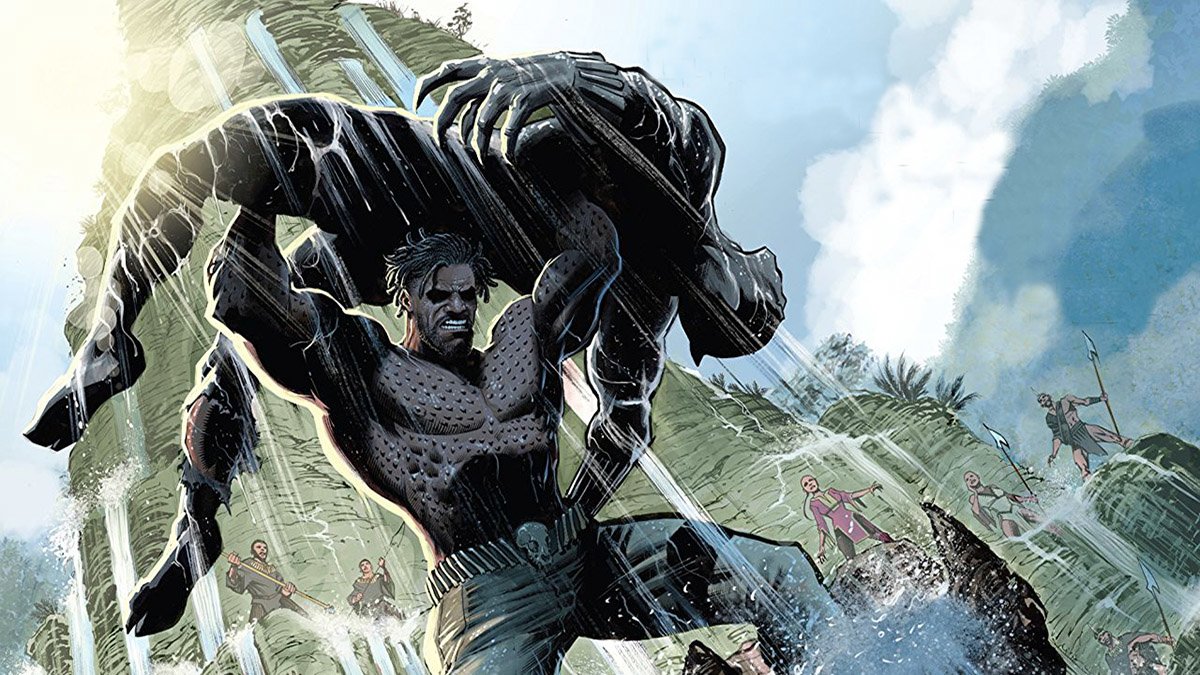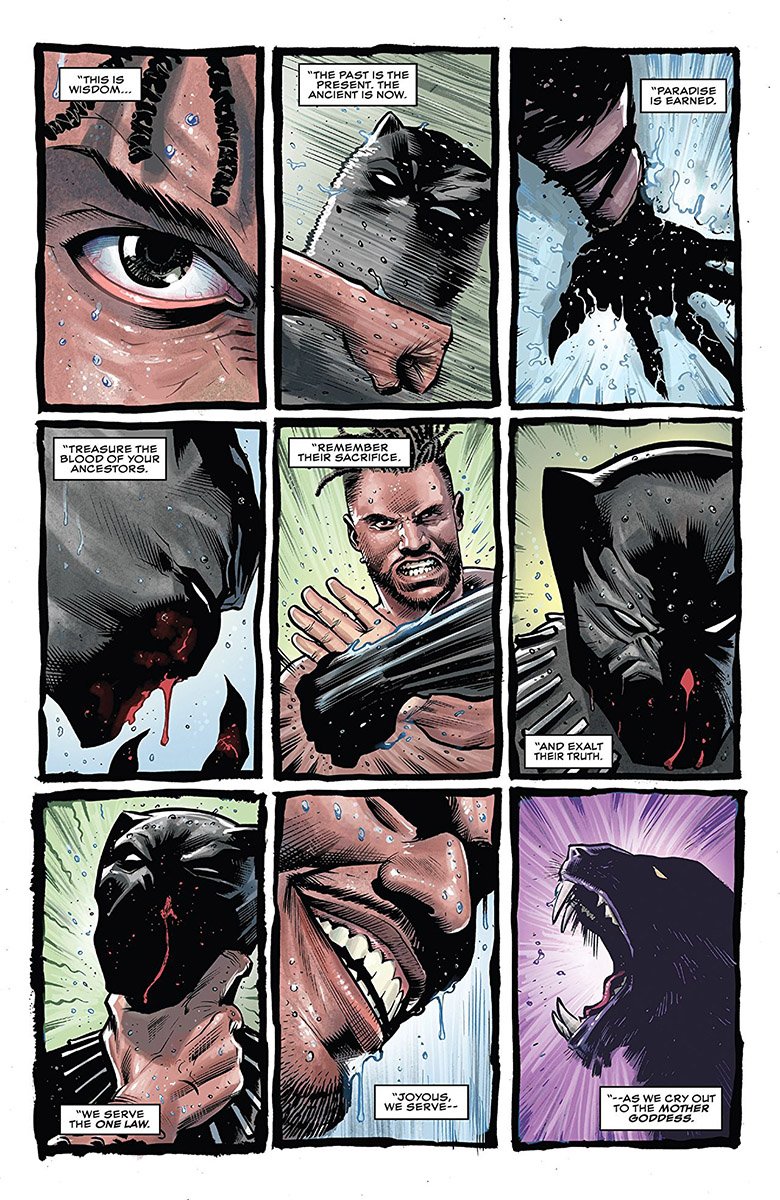Killmonger #1
What Think We Know:
Killmonger #1 brings back arguably the most profound character from the Black Panther movie. Anyone who has watched the recent Black Panther movie has been exposed to one of the most powerful sympathetic villains of the Marvel Cinematic Universe (MCU), Erik Killmonger. Michael B. Jordan’s performance coupled with Ryan Coogler’s direction drew us into Killmonger’s world. He was the villain you didn’t want to see die, because you could see why he felt as he did. You understood the origin of his hate. You felt on some level he deserved a happier ending because you understood his choice. Even if it was a choice you would never make yourself, you understood.
What many who saw the Black Panther movie don’t realize is that Erik Killmonger (real name N’Jadaka) has been around since 1973 in the comic universe. He had an entire back story and an ongoing rivalry with the Black Panther that ended with his own son swearing vengeance against the Black Panther just as N’Jadaka once did.
Now, Bryan Hill allows us to step into N’Jadaka’s world once more in Killmonger #1 and it is a comic experience that looks to be as powerful as Killmonger’s screen adaptation but it doesn’t exactly follow the MCU canon… and that is actually a good thing.
Spoiler Warning: If you have not read Killmonger #1 There May Be Spoilers Below
Creative Team:
Publisher: Marvel Writing: Bryan Hill
Art: Juan E. Ferreyra Cover: Juan E. Ferreyra
Series Rating: 5/5 Pull List Material
If you loved the Black Panther movie or the Black Panther comics then this should have been on your pull list before it came out. Killmonger #1 is a strong start for a limited series. If this is any indication of what the entire run will be like, (and I believe it is) then I recommend putting it on your pull list because you do not want to miss an issue.
From MAJK’s Coffee Corner:
Killmonger #1 is the kickoff issue for this five-issue miniseries, yet it begins with the end. The movie has already shown us Killmonger’s attempted coup will fail. We’ve seen how he dies. We know that he defeated the Black Panther in ritual combat but failed to kill him. We know the ending. Writer Bryan Hill wants us to consider what came before. He wants us to see that Killmonger is more than just an angry young man with a chip on his shoulder and an insatiable desire for vengeance through violence. Hill wants us to focus on the events and the years before. To consider the things that shaped Killmonger in the villain we think we know.
Killmonger #1 opens with a scene familiar to all who have watched the MCU Black Panther movie. Shirtless Erik has beaten T’Challa in single combat and now prepares to throw him over the edge of the waterfall. But throughout the opening, Erik mentally narrates from The Journal of the Law. This is the end and also the beginning. Hill will take us through a truly engaging story of how a smart young Wakandan, named N’Jadaka, found himself forcibly exiled to the United States, and orphaned. We will get a close look at the events that helped him evolve from a young boy to a bitter genius and ultimately into a full-blown supervillain.
A Choice
The scene flips and we see Erik graduating from MIT. The best stories start with a choice and Killmonger #1 is no different. Erik’s guidance counselor sits before him, telling him that he can have his pick of jobs. He has the opportunity to enjoy a successful and peaceful life. But Erik is not willing to or can’t step away from his desire for revenge. During the discussion Erik flashes back to how he got to where he is today.
In this respect the story diverges from MCU canon and pulls in elements of Killmonger’s comics back story. Ulysses Klaue and his mercenaries forced N’Jadaka’s father, N’Jobu, into helping them as they attacked Wakanda. We see Erik/N’Jadaka at the scene of his father’s death being rescued and then collected by Klaue. There’s a sense that Klaue sees the young N’Jadaka not as a human but as a tool. This is one of the many elements that precipitates Erik’s choice to step away from one potential future and step into another darker future.
New & Unexpected Characters
Even as he has graduated from MIT, and in spite of all the promising options that lay before him, Killmonger is already focused on his goal. His goal is not the Throne of the Nation that exiled him… not yet. At this point his goal is simpler. He intends to take out the man responsible for his father’s death. He abandons the promising post-MIT future in favor of revenge. He intends to end Ulysses Klaue.
Of course, that doesn’t go quite the way Killmonger planned, but then, too often in life things don’t goes as we plan. As Erik has his sights set on Klaue, he’s given a painful introduction to a group of assassins working for the one and only Kingpin. It was unexpected to see the Kingpin in this comic and yet he fit right in. His presence made sense. Kingpin’s assassins, known as Knight, Rook, and King, they too see value in him, but again they see him as a tool. Still, it is that value they see that saves Erik’s life. I’m intrigued to see how this plays out.
Lessons in Tragedy
Beginning with Killmonger #1, Bryan Hill is crafting a story that paints a more human picture of Killmonger. Hill builds a deeper, more nuanced Killmonger whom he will ultimately take to Wakanda. It is this missing part of Killmonger’s tale, though, that Hill weaves. We will see Erik gain the skills that made him capable of taking on T’Challa. In Killmonger #1, we will not see the Killmonger that we identify with Black Panther but we will follow Hill as he guides Erik to that place. Through the adventures in New York and wherever else Hill takes us, we will see N’Jadaka become Killmonger and we will know him better.
Make no mistake though, this will be a tragedy. Hill will walk us down Erik’s path of violence and anger and rage, and we will see the world that it creates around him. A part of us will identify with Erik and the feelings that he’s wrestling with and we will want him to win. We are watching the fall of a powerful, brilliant character with so much potential and maybe, hopefully, we will learn much.
Hill also explores an aspect of Killmonger that was barely touched on in the movie: the inner spiritual life of Killmonger. Already present in Killmonger #1 are spiritual lessons and moments. He considers the teachings of his father and communes with Mother Bast. These moments show the conflict within him. Bast addresses him by his birth name, N’Jadaka, and warns him to put down his war and return home. The sadness in his response is profound. Separated from his nation at such a young age, knowledge of his heritage has come in bits and pieces but his faith is not entirely lost even as he navigates a world dominated by people he can only see as colonizers. His hatred for those he sees as colonizers is clear and I am sure we will learn more of what fuels it, though we already have a good idea.
Art
I’d be remiss if I didn’t acknowledge the impressive way that Ferreyra’s art enhances this story. In many ways the art speaks as loud, if not louder than the words. The hard lines and sharp clarity of the present is juxtaposed with the softer lines and faded edges of the memories that Erik holds tightly.
Ferreyra creates a multi-layered, visual story that undergirds the powerful writing. Nowhere is this more evident than in the scenes with Bast where Ferreyra blends visual elements of the present and past. This manifests as a striking and ethereal effect visually cuing both the spirituality of the moment and Erik’s inner turmoil. My favorite page in terms of the art is the final page of this comic. Ferreyra’s artistic story-telling and the depth of his talent are on full display in that page.
MAJK’s Age Recommendation:
I’ll roll with Marvel’s 12 and up age recommendation for this issue, though there is so much to unpack in this issue that it would make for great conversations between geek parents and their children.
Best Line & Why
Best Line: “You tracked me and watched while I killed one of yours. That what you call loyalty?”
Why: I love how this line speaks to the fact that Erik has a moral code. He’s not an amoral sociopath. He has values and still sees human in people even those he kills. Moreover, this line tells us that Erik sees King very clearly. He doesn’t for one second believe that King will be loyal to him. He knows King for what he is and that will serve Erik well in the future.
Next Issue: December 19, 2018









